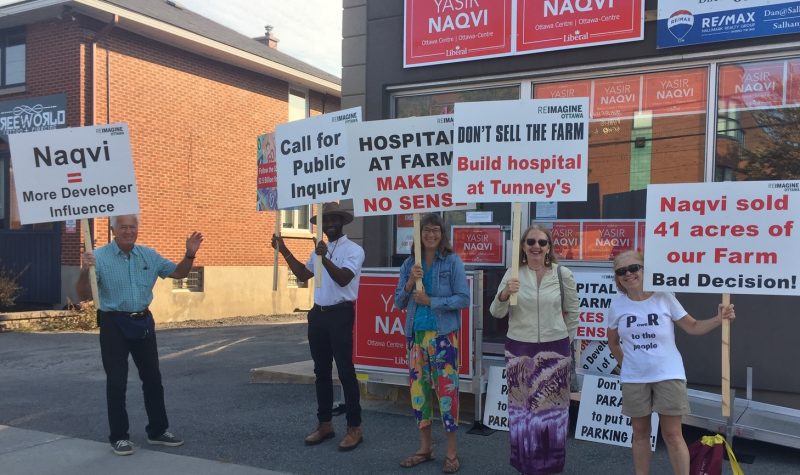The Ottawa Hospital (TOH) is under fire by some local community members for a plan to build on the Central Experimental Farm, one of Ottawa’s oldest landmarks.
Built in 1886 for research purposes, the Central Experimental Farm has since become a site for recreation, agriculture and scientific exploration enjoyed by residents of all ages. In 1998, the farm was designated a National Historic Site of Canada. Coincidentally, TOH, divided into three campuses—the Civic, the General, and Riverside—opened in the same year.
Now, TOH has set their sights on the Central Experimental Farm for the construction of a new $2.8 million Civic Campus.
A group called Reimagine Ottawa, consisting of local residents concerned about developer influence, has been attempting to halt construction on the farm for years.
Valerie Swinton, a member of Reimagine Ottawa who grew up close to the Experimental Farm, says it has always provided respite for herself and her family.
“Of course, the farm has always been a central place for recreation for me and my family,” says Swinton. “I can remember tobogganing there when my children were very small.”
Swinton is concerned about losing a piece of history, as well as the lack of transparency she says has plagued the whole development process. She says the process by which it was selected to be the future site for the Civic campus was “highly irregular.”
Beginning in 2007, plans for the construction of a new Civic campus were discussed among board members, who enlisted a steering committee to draft a master plan. The committee concluded that it would be easier and more cost-effective to build a new Civic campus, rather than rebuilding the old one.
In 2016, the National Capital Commission (NCC) conducted a six-month review of 12 potential sites for the development, four of which were located at the Central Experimental Farm. The review included extensive consultations with over 8,000 residents. Additionally, the NCC held an open house consultation, at which a majority of the 400 attendees spoke against the four sites at the Central Experimental Farm.
In the end, the NCC recommended the site at Tunney’s Pasture, citing it would have the least negative impact on the surrounding environment.
To residents, it may have seemed set in stone: Tunney’s Pasture would be the future location for the Civic Hospital.
However, in late November 2016, TOH board members met privately to discuss the decision. Shortly afterwards, they published a statement rejecting NCC’s selection, citing problems with accessibility, cost and timeliness.
“We cannot in good faith support Tunney’s Pasture as the future location for the Civic Campus,” the statement from Board Chair James McCracken reads.
Swinton says the explanation for the decision was “flimsy."
“The hospital was allowed to reject it,” says Swinton. “And I don't know how a hospital board has greater power than the federal government, [or] the National Capital Commission.”
In spite of opposition from members of the community, plans went forward to begin development of the Central Experimental Farm site for the future Civic Campus, with the support of Mayor Jim Watson and Coun. Jan Harder, and MP for Ottawa Centre Catherine McKenna. The Minister of Canadian Heritage at the time, Melanie Joly, also gave her approval to the site.
A 25-hectare parcel of land was granted to TOH for development. The hospital is being constructed in phases, the first of which began in 2021 with the widening of the O-Train trench.
The TOH Master Plan indicates that the second phase of construction, which will begin this year, will erect a four-storey parking garage at the intersection of Preston and Carling. It’s construction would require the destruction of historic Queen Juliana Park. The garage is set to be completed by the end of 2023.
“The hospital desperately needs money,” says Swinton. “And the hospital does a lot of its financing through parking fees. So it's to their advantage to get that up quickly.
Swinton says that in spite of their continued opposition, Reimagine Ottawa knows that once the garage is completed, there will be no stopping the hospital from being built. However, that hasn’t stopped them from circulating a petition, now with nearly 7,000 signatures, and requesting an official inquiry into the process.
During his campaign, newly elected MP for Ottawa Centre Yasir Naqvi proposed to “introduce a law to protect the Central Experimental Farm, forever.”
Other Ottawa politicians such as Ottawa Centre MPP Joel Harden and Coun. Shawn Menard have lent their support to the cause. Harden and Menard have been demanding an environmental impact assessment for the site since November 2021.
CHUO reached out to TOH for comment and the board responded with a written statement.
“The Ottawa Hospital is continuing to work with the City of Ottawa to consult with stakeholders and communities across the greater Ottawa region on the proposed design for its new campus project. The design is not yet final and will be adjusted based on consultations with the public and provincial and municipal governments," the statement reads. "When it opens in 2028, The Ottawa Hospital’s new Civic development will be a regional trauma, neurosciences and acute care centre unlike any other in our region. It will serve patients across Ottawa, Eastern Ontario, Western Quebec and Nunavut. As the project moves ahead through each stage of the Ministry of Health’s Capital Planning Process, the hospital will continue to work with the community and government and welcome their feedback.”
Additionally, TOH stated that they have obtained a 99-year lease for the lands from the federal government, beginning in 2018. They say the site at the Central Experimental Farm was chosen for several reasons, including that it is “easily accessible to patients and emergency vehicles and located in the core of the city, which is essential for the region.”
Listen to the CHUO story below:


